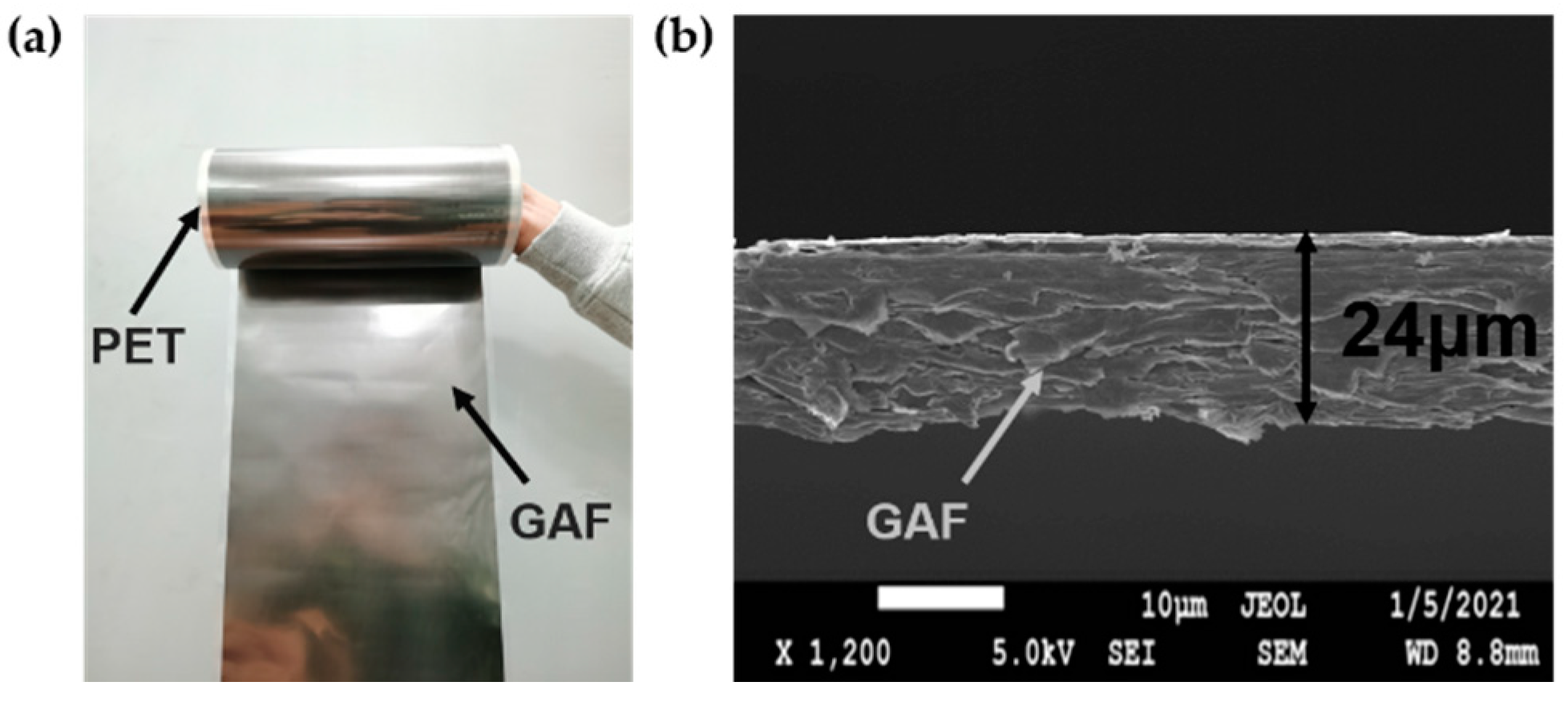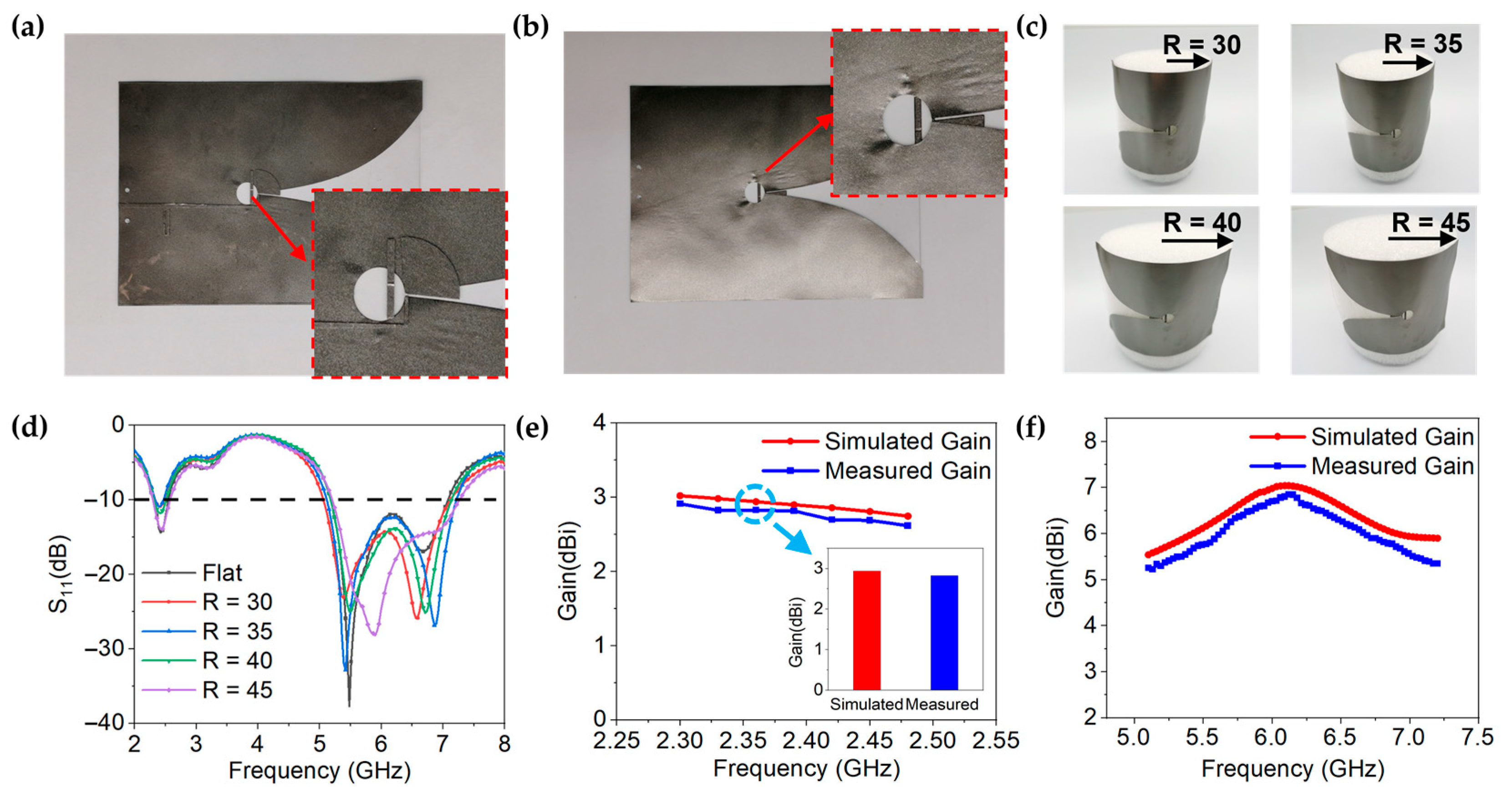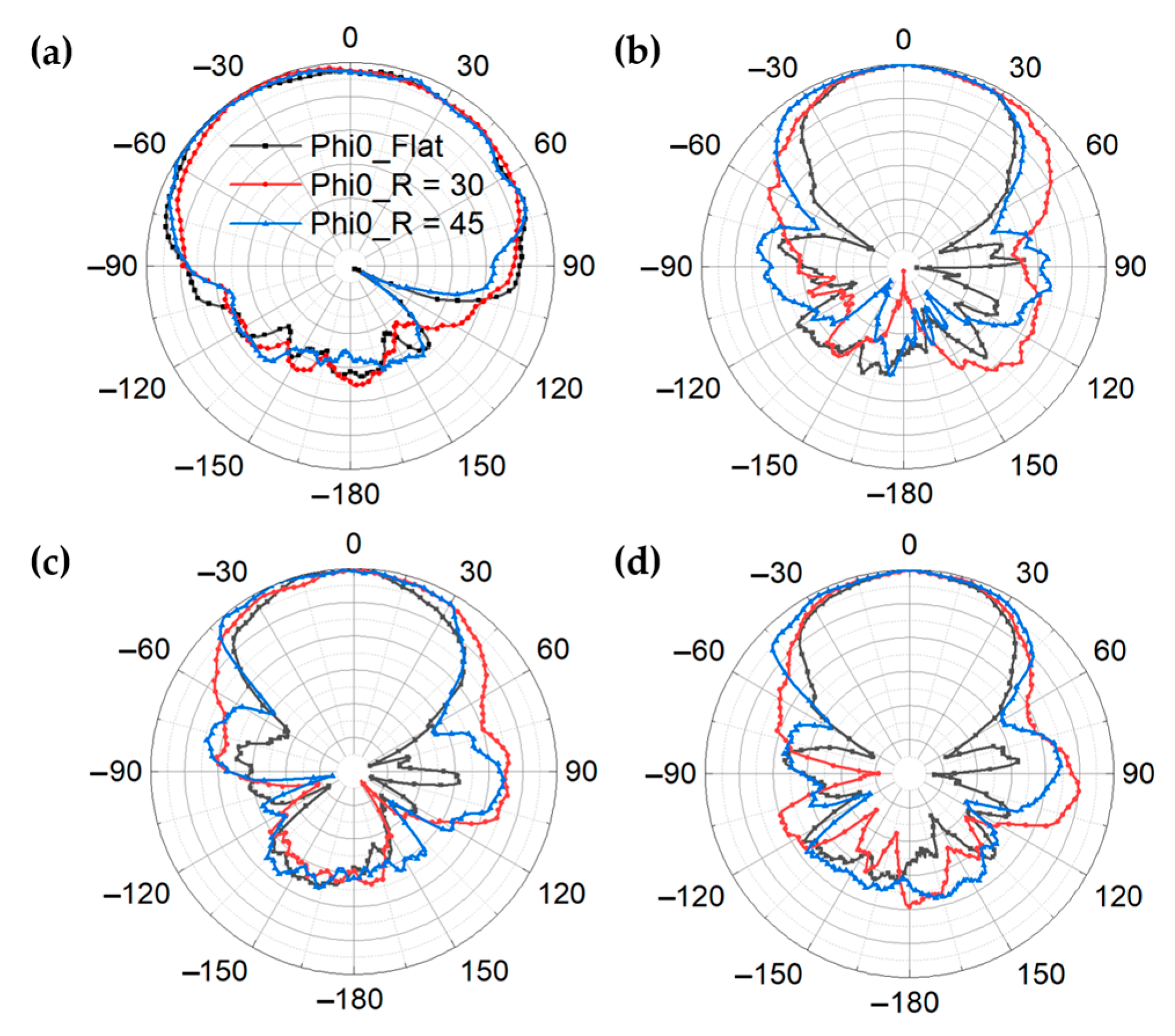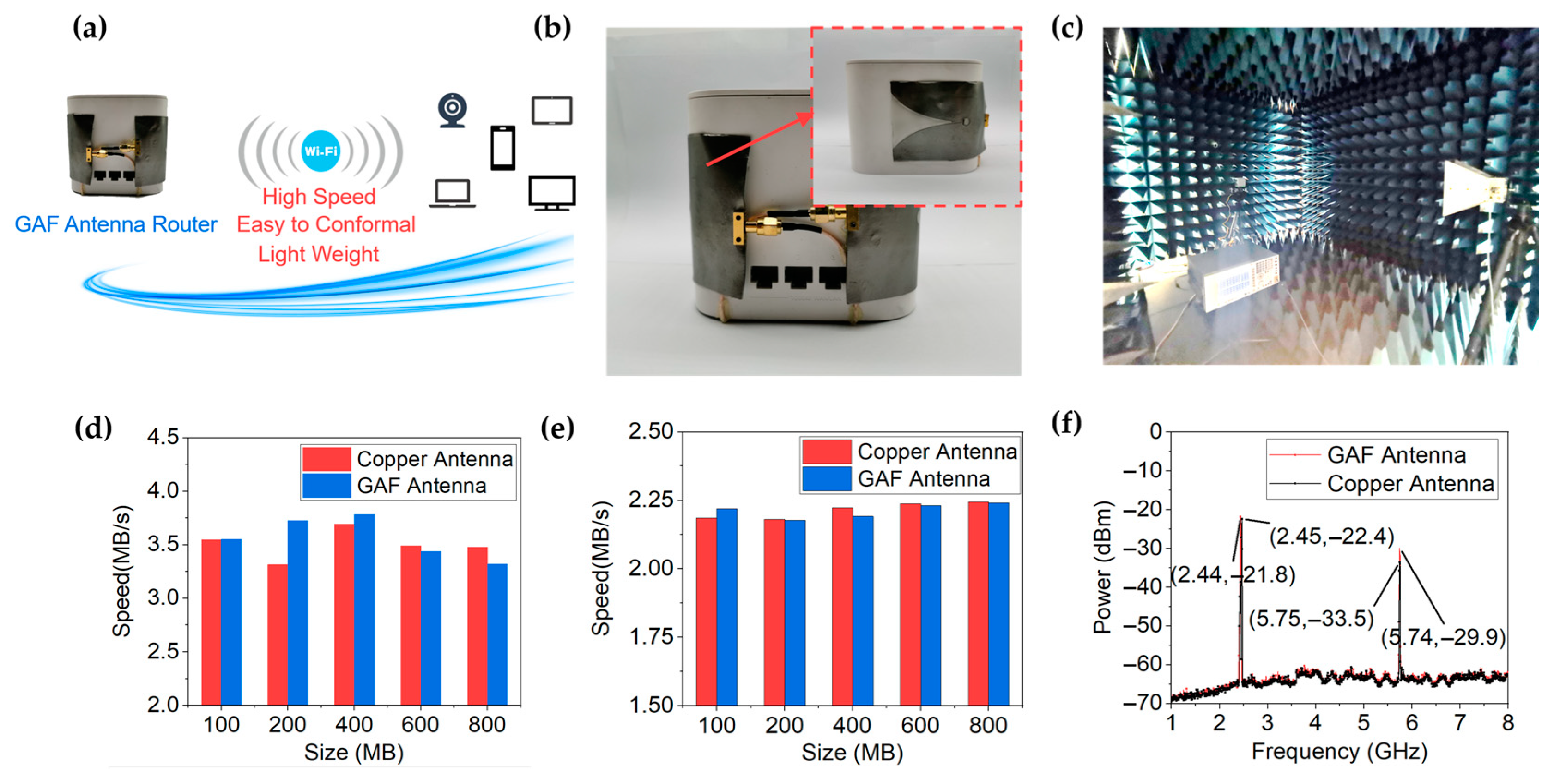A Dual-Band Conformal Antenna Based on Highly Conductive Graphene-Assembled Films for 5G WLAN Applications
Abstract
:1. Introduction
2. Materials and Methods
3. Results and Discussion
3.1. Design and Simulation of GAF Dual-Band Antenna
3.2. Conformal Characteristics of GAF Antenna
3.3. Fabrication and Measurement of GAF Dual-Band Antenna
4. Conclusions
Author Contributions
Funding
Institutional Review Board Statement
Informed Consent Statement
Data Availability Statement
Conflicts of Interest
References
- Jun, S.Y.; Elibiary, A.; Sanz-Izquierdo, B.; Winchester, L.; Bird, D.; McCleland, A. 3-D Printing of Conformal Antennas for Diversity Wrist Worn Applications. IEEE Trans. Compon. Packag. Manuf. Technol. 2018, 8, 2227–2235. [Google Scholar] [CrossRef] [Green Version]
- Yinusa, K.A. A Dual-Band Conformal Antenna for GNSS Applications in Small Cylindrical Structures. IEEE Antennas Wirel. Propag. Lett. 2018, 17, 1056–1059. [Google Scholar] [CrossRef]
- Sanchez-Olivares, P.; Sanchez-Dancausa, P.; Masa-Campos, J.L.; Iglesias-Menendez-de-la-Vega, M.; Garcia-Marin, E. Circular Conformal Array Antenna with Omnidirectional and Beamsteering Capabilities for 5G Communications in the 3.5-GHz Range [Wireless Corner]. IEEE Antennas Propag. Mag. 2019, 61, 97–108. [Google Scholar] [CrossRef]
- Pal, A.; Mehta, A.; Goonesinghe, H.; Mirshekar-Syahkal, D.; Nakano, H. Conformal Beam-Steering Antenna Controlled by a Raspberry Pi for Sustained High-Throughput Applications. IEEE Trans. Antennas Propag. 2018, 66, 918–926. [Google Scholar] [CrossRef] [Green Version]
- Nikolayev, D.; Joseph, W.; Skrivervik, A.; Zhadobov, M.; Martens, L.; Sauleau, R. Dielectric-Loaded Conformal Microstrip Antennas for Versatile In-Body Applications. IEEE Antennas Wirel. Propag. Lett. 2019, 18, 2686–2690. [Google Scholar] [CrossRef] [Green Version]
- Wright, M.D.; Baron, W.; Miller, J.; Tuss, J.; Zeppettella, D.; Ali, M. MEMS Reconfigurable Broadband Patch Antenna for Conformal Applications. IEEE Trans. Antennas Propag. 2018, 66, 2770–2778. [Google Scholar] [CrossRef]
- Yang, H.; Fan, Y.; Liu, X. A Compact Dual-Band Stacked Patch Antenna with Dual Circular Polarizations for BeiDou Navigation Satellite Systems. IEEE Antennas Wirel. Propag. Lett. 2019, 18, 1472–1476. [Google Scholar] [CrossRef]
- Chen, Y.; Zhao, J.; Yang, S. A Novel Stacked Antenna Configuration and its Applications in Dual-Band Shared-Aperture Base Station Antenna Array Designs. IEEE Trans. Antennas Propag. 2019, 67, 7234–7241. [Google Scholar] [CrossRef]
- Kong, L.; Xu, X. A Compact Dual-Band Dual-Polarized Microstrip Antenna Array for MIMO-SAR Applications. IEEE Trans. Antennas Propag. 2018, 66, 2374–2381. [Google Scholar] [CrossRef]
- Le, T.T.; Yun, T.Y. Miniaturization of a Dual-Band Wearable Antenna for WBAN Applications. IEEE Antennas Wirel. Propag. Lett. 2020, 19, 1452–1456. [Google Scholar] [CrossRef]
- Berges, R.; Fadel, L.; Oyhenart, L.; Vigneras, V.; Taris, T. Conformable Dual-Band Wireless Energy Harvester Dedicated to the Urban Environment. Microw. Opt. Technol. Lett. 2020, 62, 3391–3400. [Google Scholar] [CrossRef]
- Haerinia, M.; Noghanian, S. A Printed Wearable Dual-Band Antenna for Wireless Power Transfer. Sensors 2019, 19, 1732. [Google Scholar] [CrossRef] [PubMed] [Green Version]
- Hussain, N.; Awan, W.A.; Naqvi, S.I.; Ghaffar, A.; Zaidi, A.; Naqvi, S.A.; Iftikhar, A.; Li, X.J. A Compact Flexible Frequency Reconfigurable Antenna for Heterogeneous Applications. IEEE Access 2020, 8, 173298–173307. [Google Scholar] [CrossRef]
- Sayem, A.S.M.; Simorangkir, R.B.V.B.; Esselle, K.P.; Hashmi, R.M. Development of Robust Transparent Conformal Antennas Based on Conductive Mesh-Polymer Composite for Unobtrusive Wearable Applications. IEEE Trans. Antennas Propag. 2019, 67, 7216–7224. [Google Scholar] [CrossRef]
- Saeed, S.M.; Balanis, C.A.; Birtcher, C.R. Inkjet-Printed Flexible Reconfigurable Antenna for Conformal WLAN/WiMAX Wireless Devices. IEEE Antennas Wirel. Propag. Lett. 2016, 15, 1979–1982. [Google Scholar] [CrossRef]
- Abutarboush, H.F.; Farooqui, M.F.; Shamim, A. Inkjet-Printed Wideband Antenna on Resin-Coated Paper Substrate for Curved Wireless Devices. IEEE Antennas Wirel. Propag. Lett. 2016, 15, 20–23. [Google Scholar] [CrossRef] [Green Version]
- Castro, A.T.; Sharma, S.K. Inkjet-Printed Wideband Circularly Polarized Microstrip Patch Array Antenna on a PET Film Flexible Substrate Material. IEEE Antennas Wirel. Propag. Lett. 2018, 17, 176–179. [Google Scholar] [CrossRef]
- Keller, S.D.; Zaghloul, A.I.; Alvarez, N.T.; Malik, R.; Shanov, V.; Schulz, M.J.; Mast, D.B. Effects of Metal Nanoparticle Doping and In Situ Atmospheric Pressure Plasma Treatment on Carbon Nanotube Sheet Antenna Performance. IEEE Antennas Wirel. Propag. Lett. 2017, 16, 1076–1079. [Google Scholar] [CrossRef]
- Fang, R.; Song, R.; Zhao, X.; Wang, Z.; Qian, W.; He, D. Compact and Low-Profile UWB Antenna Based on Graphene-Assembled Films for Wearable Applications. Sensors 2020, 20, 2552. [Google Scholar] [CrossRef] [PubMed]
- Song, R.; Wang, Z.; Zu, H.; Chen, Q.; Mao, B.; Wu, Z.P.; He, D. Wideband and Low Sidelobe Graphene Antenna Array for 5G Applications. Sci. Bull. 2021, 66, 103–106. [Google Scholar] [CrossRef]
- Song, R.; Chen, X.; Jiang, S.; Hu, Z.; Liu, T.; Calatayud, D.; Mao, B.; He, D. A Graphene-Assembled Film Based MIMO Antenna Array with High Isolation for 5G Wireless Communication. Appl. Sci. 2021, 11, 2382. [Google Scholar] [CrossRef]
- Zhang, J.; Song, R.; Zhao, X.; Fang, R.; Zhang, B.; Qian, W.; Zhang, J.; Liu, C.; He, D. Flexible Graphene-Assembled Film-Based Antenna for Wireless Wearable Sensor with Miniaturized Size and High Sensitivity. ACS Omega 2020, 5, 12937–12943. [Google Scholar] [CrossRef] [PubMed]
- Tang, D.; Wang, Q.; Wang, Z.; Liu, Q.; Zhang, B.; He, D.; Wu, Z.; Mu, S. Highly Sensitive Wearable Sensor Based On a Flexible Multi-Layer Graphene Film Antenna. Sci. Bull. 2018, 63, 574–579. [Google Scholar] [CrossRef]
- Wang, Z.; Li, P.; Song, R.; Qian, W.; Zhou, H.; Wang, Q.; Wang, Y.; Zeng, X.; Ren, L.; Yan, S.; et al. High Conductive Graphene Assembled Films with Porous Micro-Structure for Freestanding and Ultra-Low Power Strain Sensors. Sci. Bull. 2020, 65, 1363–1370. [Google Scholar] [CrossRef]
- Zhou, W.; Liu, C.; Huang, G.L.; Xia, W.; Zhang, J.; He, D.; Wu, Z. Design and Manufacture of Lowpass Microstrip Filter with High Conductivity Graphene Films. Microw. Opt. Technol. Lett. 2019, 61, 972–978. [Google Scholar] [CrossRef]
- Bangqi, H.; Li, S.; Song, R.; Hou, Z.; Liu, C.; He, D. High Conductivity Graphene-Assembled Film-Based Bandpass Filter for 5G Applications. Int. J. RF Microw. Comput.-Aided Eng. 2021, 31, e22602. [Google Scholar] [CrossRef]
- Zu, H.R.; Wu, B.; Zhang, Y.H.; Zhao, Y.T.; Song, R.G.; He, D.P. Circularly Polarized Wearable Antenna with Low Profile and Low Specific Absorption Rate Using Highly Conductive Graphene Film. IEEE Antennas Wirel. Propag. Lett. 2020, 19, 2354–2358. [Google Scholar] [CrossRef]
- Zhang, B.; Tang, X.; Zhang, J.; Liu, C.; He, D.; Wu, Z.P. Long Read Range and Flexible UHF RFID Tag Antenna Made of High Conductivity Graphene-Based Film. Int. J. RF Microw. Comput.-Aided Eng. 2020, 30, 104–112. [Google Scholar] [CrossRef]
- Li, S.; Song, R.; Zhang, B.; Huang, B.; Zhao, X.; He, D. Wearable Near-Field Communication Bracelet Based on Highly Conductive Graphene-Assembled Films. Int. J. RF Microw. Comput.-Aided Eng. 2021, 31, 325–335. [Google Scholar] [CrossRef]
- Li, Z.; Yin, C.; Zhu, X. Compact UWB MIMO Vivaldi Antenna with Dual Band-Notched Characteristics. IEEE Access 2019, 7, 38696–38701. [Google Scholar] [CrossRef]
- Xu, Y.; Wang, J.; Ge, L.; Wang, X.; Wu, W. Design of a Notched-Band Vivaldi Antenna with High Selectivity. IEEE Antennas Wirel. Propag. Lett. 2018, 17, 62–65. [Google Scholar] [CrossRef]
- Wang, Z.; Dong, Y. Low-Profile Omnidirectional WIFI Antennas with Pattern Reconfigurability Inspired by Meta-Resonators. IEEE Trans. Antennas Propag. 2020, 12, 12–18. [Google Scholar] [CrossRef]
- Tu, Y.; Al-Yasir, Y.I.A.; Ojaroudi Parchin, N.; Abdulkhaleq, A.M.; Abd-Alhameed, R.A. A Survey on Reconfigurable Microstrip Filter–Antenna Integration: Recent Developments and Challenges. Electronics 2020, 9, 1249. [Google Scholar] [CrossRef]
- Xie, Y.; Chen, F.; Chu, Q.; Xue, Q. Dual-Band Coaxial Filter and Diplexer Using Stub-Loaded Resonators. IEEE Trans. Microw. Theory 2020, 68, 2691–2700. [Google Scholar] [CrossRef]
- Hsieh, C.; Wu, C.; Ma, T. A Compact Dual-Band Filtering Patch Antenna Using Step Impedance Resonators. IEEE Antennas Wirel. Propag. Lett. 2015, 14, 1056–1059. [Google Scholar] [CrossRef]
- Chen, K.; Lo, Y.; Lee, Y.; Wu, S.; Tarng, J. Compact Four Bands Hybrid Filtering Antenna Using Step Impedance Resonators and Tuning Stub Transition Structures. IET Microw. Antennas Propag. 2018, 12, 1126–1131. [Google Scholar] [CrossRef]
- Chen, F.; Li, R.; Qiu, J.; Chu, Q. Sharp-Rejection Wideband Bandstop Filter Using Stepped Impedance Resonators. IEEE Trans. Compon. Packag. Manuf. Technol. 2017, 7, 444–449. [Google Scholar] [CrossRef]






Publisher’s Note: MDPI stays neutral with regard to jurisdictional claims in published maps and institutional affiliations. |
© 2021 by the authors. Licensee MDPI, Basel, Switzerland. This article is an open access article distributed under the terms and conditions of the Creative Commons Attribution (CC BY) license (https://creativecommons.org/licenses/by/4.0/).
Share and Cite
Hu, Z.; Xiao, Z.; Jiang, S.; Song, R.; He, D. A Dual-Band Conformal Antenna Based on Highly Conductive Graphene-Assembled Films for 5G WLAN Applications. Materials 2021, 14, 5087. https://doi.org/10.3390/ma14175087
Hu Z, Xiao Z, Jiang S, Song R, He D. A Dual-Band Conformal Antenna Based on Highly Conductive Graphene-Assembled Films for 5G WLAN Applications. Materials. 2021; 14(17):5087. https://doi.org/10.3390/ma14175087
Chicago/Turabian StyleHu, Zelong, Zhuohua Xiao, Shaoqiu Jiang, Rongguo Song, and Daping He. 2021. "A Dual-Band Conformal Antenna Based on Highly Conductive Graphene-Assembled Films for 5G WLAN Applications" Materials 14, no. 17: 5087. https://doi.org/10.3390/ma14175087





